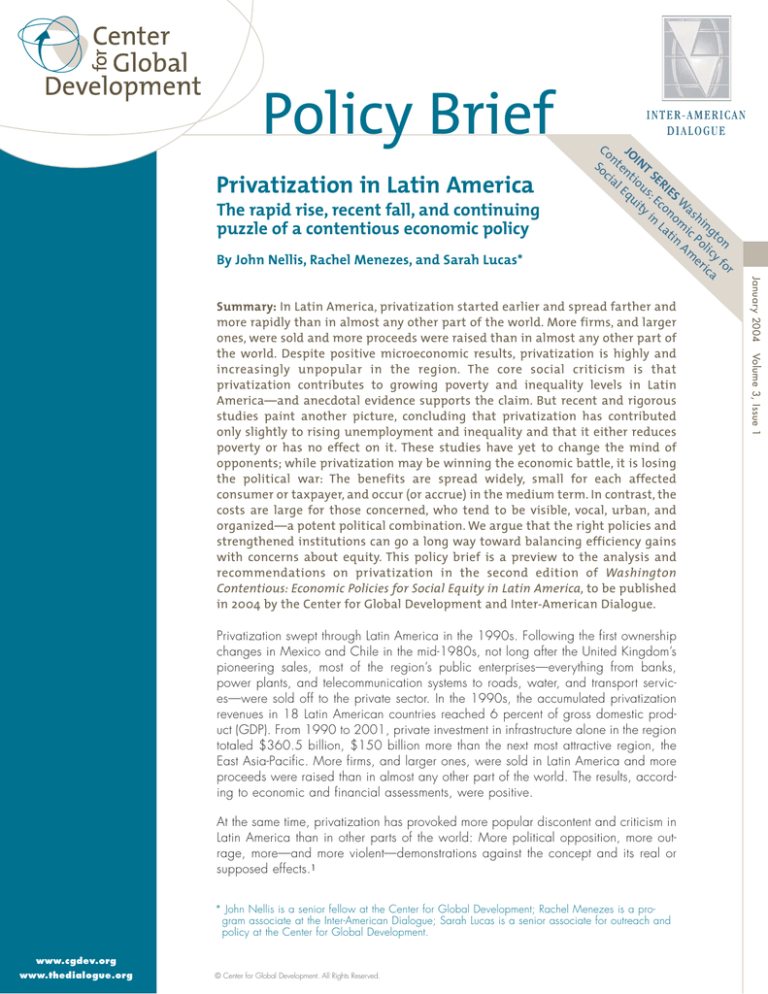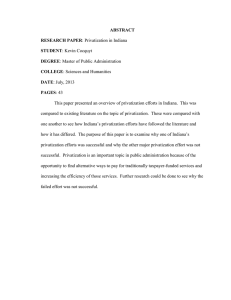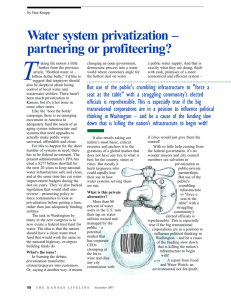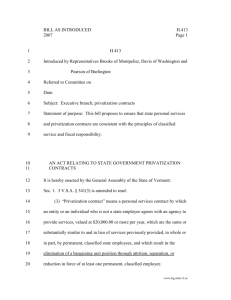
Policy Brief
Privatization in Latin America
The rapid rise, recent fall, and continuing
puzzle of a contentious economic policy
By John Nellis, Rachel Menezes, and Sarah Lucas*
Privatization swept through Latin America in the 1990s. Following the first ownership
changes in Mexico and Chile in the mid-1980s, not long after the United Kingdom’s
pioneering sales, most of the region’s public enterprises—everything from banks,
power plants, and telecommunication systems to roads, water, and transport services—were sold off to the private sector. In the 1990s, the accumulated privatization
revenues in 18 Latin American countries reached 6 percent of gross domestic product (GDP). From 1990 to 2001, private investment in infrastructure alone in the region
totaled $360.5 billion, $150 billion more than the next most attractive region, the
East Asia-Pacific. More firms, and larger ones, were sold in Latin America and more
proceeds were raised than in almost any other part of the world. The results, according to economic and financial assessments, were positive.
At the same time, privatization has provoked more popular discontent and criticism in
Latin America than in other parts of the world: More political opposition, more outrage, more—and more violent—demonstrations against the concept and its real or
supposed effects.1
* John Nellis is a senior fellow at the Center for Global Development; Rachel Menezes is a program associate at the Inter-American Dialogue; Sarah Lucas is a senior associate for outreach and
policy at the Center for Global Development.
www.cgdev.org
www.thedialogue.org
© Center for Global Development. All Rights Reserved.
Volume 3, Issue 1
Summary: In Latin America, privatization started earlier and spread farther and
more rapidly than in almost any other part of the world. More firms, and larger
ones, were sold and more proceeds were raised than in almost any other part of
the world. Despite positive microeconomic results, privatization is highly and
increasingly unpopular in the region. The core social criticism is that
privatization contributes to growing poverty and inequality levels in Latin
America—and anecdotal evidence supports the claim. But recent and rigorous
studies paint another picture, concluding that privatization has contributed
only slightly to rising unemployment and inequality and that it either reduces
poverty or has no effect on it. These studies have yet to change the mind of
opponents; while privatization may be winning the economic battle, it is losing
the political war: The benefits are spread widely, small for each affected
consumer or taxpayer, and occur (or accrue) in the medium term. In contrast, the
costs are large for those concerned, who tend to be visible, vocal, urban, and
organized—a potent political combination. We argue that the right policies and
strengthened institutions can go a long way toward balancing efficiency gains
with concerns about equity. This policy brief is a preview to the analysis and
recommendations on privatization in the second edition of Washington
Contentious: Economic Policies for Social Equity in Latin America, to be published
in 2004 by the Center for Global Development and Inter-American Dialogue.
January 2004
Co JO
n
So ten INT
cia ti SE
l E ou RIE
qu s: E S
ity co Wa
in nom shi
La i ng
tin c P to
Am olic n
er y fo
ica r
Privatization in Latin America
2
The Pro- and Anti-privatization Views in Latin
America
“The good…”
Most technical studies of Latin American privatization conclude that it improves firm performance—profits, operating
efficiency, and output tend to rise.
A recent study covering Argentina, Brazil, Chile,
Colombia, Mexico, and Peru found an average increase
in profits of around 30 percent in a large sample of
privatized firms. Efficiency gains averaged a remarkable
67 percent, and output increases averaged around
34 percent.
Infrastructure privatization—more than half of all sales in Latin
America—is shown to improve financial and operating performance in (most) firms, relax investment constraints, extend
network coverage and access to it, and generally enhance
the quality of services. (See Box 1.)
In Bolivia, the share of rural towns connected to long-distance telephone service increased from 25 to 33 percent
after privatization.
In Mexico, the waiting time for new telephone connection
dropped from 890 to 30 days.
In Argentina, the number of phone lines more than doubled, from 3.1 million to 6.85 million, after privatization.
In terms of fiscal benefits, privatization has brought a positive
flow of funds and reduced public debt to governments in the
region through price rationalization, retirement of accumulated debt and elimination of subsidy flows, and increased tax
revenues from more profitable and productive private firms.
In the first four years following sales in Bolivia, the government received $429 million, none of which was
derived from sale proceeds. In Mexico, privatization proceeds of about $33 billion from 1984–2000 were used
mainly to retire public debt, reduce the fiscal deficit, and
increase social spending from 6 percent of GDP in 1990
to 9.5 percent in 2000.
With this record of accomplishment, it is small wonder that
economists, finance ministers, and investment bankers rank privatization as a success in Latin America.
“…and the bad”
But Latin Americans in general hold a much less positive view
of privatization.
In 2001, a clear majority of people surveyed by
Latinobarométro in 17 countries in the region felt that privatization had not been beneficial, and by higher percentages than in previous surveys.2
A follow-up survey in 2002 showed a decline in anti-privatization sentiment in a few countries—Colombia, Peru,
Brazil, and Ecuador—but increasingly negative views in
Uruguay, Bolivia, Chile, Mexico, Venezuela, and
Argentina. In every country, fewer people agreed that “the
state should leave economic activity to the private sector”
than in 1998.
Infrastructure privatization receives the most criticism, particularly in the electricity, water, and passenger rail sectors. Part
of the problem is the perceived loss of sovereignty—that is, the
turning-over of what are seen as valuable national assets to
multinational firms or to firms based in “rival” neighboring
countries. There is also the widespread belief that privatization
leads to increased unemployment and steep increases in
prices of basic commodities. Third, there is the suspicion that
many of the large privatization and concession transactions in
the region have been tainted by collusion (of private bidders
to reduce the price paid for a firm or concession), fraud, corruption, or simply the incompetence of public officials.
Utility privatization has been particularly controversial in Latin
America.
Violent protests against water privatization and price hikes
erupted in Cochabamba, Bolivia—where the concession
was cancelled—and against electricity privatization in
Arequipa, Peru—where the government decided to abandon the sale. (See Box 2.)
Box 1: Access to Clean Water: A Question of Life and Death
Providing access to clean water and sanitation services is a fundamental challenge in developing countries, one that has
significant implications for the health of poor communities, particularly children. Diarrhea accounts for about 15 percent of
child deaths worldwide. In Argentina, three waterborne diseases are among the top 10 causes of death among young children. A recent study of privatization of the local water companies in Argentina found that child mortality fell 5–7 percent in
municipalities that privatized their water services compared with those that retained public provision. Results were most striking in the poorer locales: privatization of water services led to a 24-percent reduction in child deaths by infectious and parasitic diseases caused by dirty water.
Source: Sebastian Galani, Paul Gertler, and Ernesto Schargrodsky. 2003. “Water for Life: The Impact of Privatization of Water
Services on Child Mortality.” Unpublished paper.
1998
2000
80%
60%
20%
0%
Argentina
Bolivia
Mexico
Source: Latinobarométro 2001
In the Argentine province of Tucuman, popular protests and
poor performance led to the cancellation, after two years,
of a 30-year private concession for water provision.
Street demonstrations and burgeoning opposition have led
governments to rethink plans to privatize utilities in Panama,
Lima, Rio de Janeiro, and elsewhere in the region.
A port project and a water concession in Argentina (in addition to the one in Tucuman) have been cancelled. A telecommunications operation in Costa Rica has met a similar fate.
Dozens more privatization contracts have been called into
question and renegotiated because of unanticipated shifts in
market conditions, contract renegotiations by opportunistic private providers, and governmental inability or unwillingness to
comply with the contracts (particularly regarding
tariff increases). All this, in conjunction with the worldwide
economic slowdown, has driven away investors previously
eager to bid on infrastructure privatizations in Latin America.
The outcome has been, from 1998 to the present, a strengthening of the critics, weakening support by governments and
Privatization’s Effects on Poverty and Inequality
The early hope was that efficiency gains from privatization
would quickly produce large macroeconomic benefits:
improved fiscal health, more jobs, and higher growth. Far
fewer of these benefits have occurred than anticipated. In
many Latin American countries, the current situation is one of
persisting fiscal malaise, higher unemployment, and low
growth. This gives ammunition to the critics’ claim that privatization has been unfair, that it is a primary contributor to growing poverty and inequality.
Anecdotal evidence supports these claims.
Jobs and wages
It is incontestable that a number of Latin American privatizations have resulted in job losses.
In Argentina, 150,000 workers were dismissed due to privatizations between 1987 and 1997.
Approximately 50 percent of all employees in firms privatized in Mexico lost their jobs.
In Brazil, there was a reduction of more than 90,000 jobs
from peak employment levels in privatized railways alone.
In Nicaragua, privatization resulted in the dismissal of 15
percent of the total labor force.
Critics say this amount of job loss, falling on those whose
main source of income is wages, must result in increased
income inequality.
Access and prices
Few dispute that price increases in privatized firms are often
necessary if the firm is to modernize, meet demand, and operate without subsidies. Under state ownership, many Latin
American governments set utility prices at less than cost-covering levels, which led to scarcity, rationing, and firms starved
Box 2: Cochabamba: The Power of a Rotten Apple
Public opinion in Bolivia has been particularly unkind to privatization, partly due to one case that went horribly wrong in
early 2000. A water concession to a multinational company in the city of Cochabamba resulted in an average increase in
tariffs of 43 percent for poor consumers. This led to massive public protest, including strikes and demonstrations followed
by a declaration of martial law in the town and the eventual expulsion of the private firm. The Cochabamba protests gave
an organized voice to simmering discontent about unemployment and economic instability in Bolivia. The perceived success
of the protests catalyzed ongoing social mobilization and opposition to broader reforms—opposition that recently culminated in national unrest that led to the resignation and exile of president Sanchez de Lozada. The case of Cochabamba illustrates that concerns about privatization can serve as an easy, concrete rallying cry for vulnerable groups in the context of
economic reform, and it highlights the importance of managing individual cases of reform to minimize the short-term negative impacts felt by these groups.
3
Volume 3, Issue 1
40%
investors for existing and future privatizations, and a calling into
question of privatization’s usefulness even by its former advocates.
January 2004
Figure 1: Percent who disagree or disagree strongly
that privitisation has been beneficial
Privatization in Latin America
4
of investment capital. But critics claim that in Latin America,
the size and speed of the price adjustment has been excessive, with an overly harsh impact on poor consumers. For
instance:
In the short-lived Cochabamba water concession in
Bolivia, prices for poorer consumers went up at once by
43% on average, and doubled for a small segment of very
poor consumers.
In telecommunications, “tariff rebalancing” between long
distance and local calling generally leads to large price
increases in formerly subsidized “fixed line” or local telephone services, while introducing competition—usually
producing rapidly falling prices—in international services
and through mobile phone systems. Since the poor tend to
place most of their calls locally through fixed lines, the
price increase is concentrated among the poor.
Sometimes, as in the case of water, the effect of price
increases on the poor were offset by provisions such as a
“lifeline tariff,” where a set daily or monthly amount of initial
use is billed at a special low rate. But this scheme overlooks
the obstacle to access faced by the previously unconnected
poor—the very high connection fees charged by some privatized firms.
The Buenos Aires water and sewerage concession contract allowed the private operator to charge connection
fees of between $1,100 and $1,500 (with payments
spread over 24 months) in areas where the average
monthly income was $245 per month.
The price of privatized electricity increased in only half of
reviewed Latin American cases. But even when post-sale
prices fall—as they did in Argentina, Chile, and parts of
Peru—the benefits may not be felt, or felt as much, by the
poor. Electricity rates may vary according to the locality
served or may be adjusted based on the amount of use, with
large users receiving a lower rate. Low-income consumers
may also be disproportionately affected by price increases in
privatized mass transport services (buses), as well as in cases
when a negative concession gives private operators an
incentive to skimp on service and safety in order to maximize
returns—and government monitoring capacity is weak. (A
“negative concession” auctions a service to a private
provider not on the basis of how much is paid to obtain the
firm but rather on how little the private operator will demand
from government as a subsidy to run a stipulated level of service with a stipulated fare structure; it has been used in some
Latin American transportation reforms.)
Macroeconomic concerns
If governments sell state firms at unreasonably low prices
because of incompetence or corruption, or if the proceeds
are mismanaged, then privatization could have a negative
impact on government finances, on the provision of public
social services, and in turn on growth—contributing to poverty
and perhaps inequality.
A study concluded that close to $80 billion in privatization
inflows in Brazil in the 1990s substantially “went down the
drain in the disarray of public finances,” and that inequality
was increased.3
Overall, and despite a tendency to overlook the distributional
shortcomings of pre-privatization arrangements, the argument
that privatization adds to inequality has some merits.
The Empirical Counterargument
But more recent and rigorous studies paint a much more positive picture, concluding that privatization has contributed
only slightly to rising unemployment and inequality, and that
it either reduces or has no effect on poverty. These studies
expand the lens of examination from the negative short-term
impacts on a neighborhood or the employees of a firm, to the
longer-term, overall effects on income groups.
In most cases the numbers of workers laid off due to pri-
vatization are small relative to the entire workforce and
tend to be offset in the medium term by increased job creation produced in part by privatization and liberalization.
General unemployment increases in Latin America came
later and were caused by external shocks, labor market
rigidities, and financial indiscipline—not just privatization.
It has even been argued that privatization may have mitigated unemployment—that is, absent privatization, unemployment levels would be higher.
Benefits to the poor from increased access trump the costs of
price increases. For the poor, often without any access to
certain services, the pre-privatization price is infinite.
Increasing their access makes them better off. Overall, the
positive distributional impact of increased access to privatized utility services outweighs any negative impact of
increased tariffs, where indeed the tariffs did actually
increase. To illustrate, Figure 2 shows that in Bolivia, access
to telephone services increased dramatically following privatization, and additional connections were concentrated
among lower-income consumers. Ownership change may
not have been the only cause of the pro-poor network
expansion, but it is hard to ignore the clear break points in
rates of growth that occur in 1994, the year of privatization.
Evidence such as this sways economists and technicians, but it
does little to change the negative public perception of privatization in Latin America. The argument is not being fought
solely on economic and financial grounds; the reasons for the
unpopularity of privatization are also, indeed primarily, political.
% with access
Highest income
Lowest income
1989
1994
1999
Year of Privatization
Explaining the “Disconnect”
Privatization is an easy target. The foes of liberal reform
and globalization find in privatization a simple and visible
summation of all they oppose. While the negative results of
some liberal reforms are too indirect and unclear to spur
active opposition, privatization’s costs appear evident. The
concept is simple. Costs concentrated among a few can
easily be described as costs to society as a whole, and
pro-privatization arguments tend to be too complex by comparison. The claims fall on fertile political ground. Anti-privatization movements are numerous and popular in Latin
America and receive strong support from trade unions.
Overselling the promise; underselling the complexity.
Privatization supporters have often misplayed their hand.
Many Latin American governments oversimplified the economic situations they faced and ended up overselling privatization as a key to rapid and sustained growth and
social progress. When growth and jobs did not materialize, they were unable to manage the high expectations of
consumers and voters.
The squeaky wheel gets the grease. Privatization is a politi-
cal conundrum. Its benefits tend to be spread widely, among
amorphous, unorganized segments of the public; benefits
are small for each affected consumer or taxpayer, and they
occur or accumulate in the medium term. For instance, a
5–10 percent drop in average electricity tariffs is in the
aggregate a substantial and worthwhile gain for any economy. But consumers hardly mobilize politically in favor of a
policy or a reforming regime because of such gains, even if
it means a few dollars saved in electricity bills at the end of
the month. In addition, many of the beneficiaries of privatization’s increased access to services are the poor, who had
little or no formal access to utilities infrastructure and who are
both less organized and more difficult to mobilize. In any
On the other hand, the costs of privatization are concentrated
among a visible, vocal, and usually urban few—dismissed
workers represented by powerful unions, bureaucrats who
lose authority and perks, managers and board members of formerly state-owned firms, and the middle- and upper-income
consumers of subsidized services. Though the sum of their welfare losses may be much less than the aggregate gain, these
actors possess “voice” and access to power; they can and do
make their needs and views known. They are motivated to do
so because the losses for each affected individual are comparatively large and they occur in the very short term. Losses
of comparatively large magnitude among stakeholders of this
nature typically result in protest, direct political action, or
bureaucratic delay and misdirection. The reality is that it is easier to mobilize protest against losses than to engender gratitude for gains, and the gratitude from the awarding of any
gain is far less politically powerful than the protest generated
by the imposition of an equivalent loss.
Public awareness and adjustment programs. Many liberal
economic policy reforms create medium-term, economywide benefits but, when implemented, impose costs on
some previously benefiting segments of society, who then
take steps to protect their interests, often by portraying their
loss of privilege as a threat to society. This is not unique to
privatization. An effective political system that reconciles the
demands for maximizing, spreading, and publicizing the
positive outcomes of privatization while acknowledging
and addressing the experiences of the vulnerable and sensitive groups is critical.
Conclusions: Making the Most of Privatization
Few public policies have moved in and out of fashion in such
pendulum-like manner as privatization. The cyclical process of
privatization and nationalization has long been recognized
and even predicted: Private provision of utility services eventually leads to conflicts over prices and what is a “reasonable”
return on investment. The government then responds with more
strenuous intervention and regulation, which eventually
decrease returns—causing private operators to quit the market
or governments to take over the service. What follows is populist pricing, insufficient investment, and a failure to sustain
reform short of ownership, leading to problems of both quantity and quality of service—and provoking once more the
increasing involvement of the private sector, first as managers
and financiers, and finally as owners. And the cycle begins
anew. Privatization events in Latin America from 1980 through
2000 approximated this model.
5
Volume 3, Issue 1
80
70
60
50
40
30
20
10
0
case, some consumers, particularly poor ones, probably do
not associate gains from reduced tariffs as having anything
to do with the privatization of the service.
January 2004
Figure 2: Bolivia: Household Access to Telephone
Services, 1989–99
Privatization in Latin America
6
A prime lesson of this experience is that privatization is but one
aspect of liberalizing reform. While there is little real threat of
a move toward large-scale renationalization in Latin America,
privatization—as with any other liberalizing reform—must be
perceived by the public as working fairly and well. That
requires embedding privatization in a set of well-functioning
legal and economic institutions that promote, monitor, and render transparent market operations. These include:
definition and protection of property rights;
contract enforcement and commercial dispute settlement
through lawful, peaceful means, and court decisions that
are timely and based on the law, not on payments or social
precedence;
independent, well-staffed agencies to regulate the natural
monopoly elements of private utilities (and that deliver timely, law-based decisions that are reasonable and credible
for both investors and consumers);
functioning bankruptcy and insolvency regimes for firms
operating in competitive markets; and, in general,
a public administration that meets minimum standards of
predictability, competence, and probity.
These institutions provide stability and predictability to market
operations, lowering transaction costs. The more careful and
extensive the preparation devoted to the institutional underpinnings of privatization, the better the results, in both efficiency and equity terms (for example, Chile versus Argentina).
Unfortunately, the countries that stand to benefit most from
liberalizing reform and privatization are those with the
weakest institutions and the most inefficient and corrupt public sectors. In addition, it is not clear exactly what governments, and those that assist them, can and should do to aid
the emergence of these policies and institutions and to
enhance their capacity. Governments thus face a practical
question: Is it better to put efforts into the creation and reinforcement of regulatory agencies to oversee a private
provider? Or should efforts be devoted to reforming stateowned enterprises without going so far as to change
ownership?
For Latin America, the answer is a continuation of private
involvement and ownership, accompanied by expanded
efforts to put in place the needed institutional framework.
Part of the anti-privatization sentiment in the region stems
from a lack of understanding of and appreciation for what
has been accomplished. This is combined with a tendency
to forget both the poor performance of state-owned infrastructure firms in the past and the very poor track record of
performance-improvement attempts that did not involve the
private sector. The crucial question has become, How do we
strengthen the institutional underpinnings of private participation to better balance efficiency gains with equity concerns? Box 3 outlines recommendations for better achieving
this balance.
What is the Washington Contentious?
Washington Contentious: Economic Policy for Social Equity in Latin America is a joint program of the Center for Global
Development and the Inter-American Dialogue. The program aims to galvanize attention and political support for a policy agenda that promotes social equity in the midst of economic reform and transition in Latin America. At the heart of the program is the
revision of the first Washington Contentious book to take into account the dramatic economic and social change in the region
since early 2001, including the financial crises in Argentina and Brazil; the increasing fatigue with fiscal austerity, unemployment
and stagnant wages; and the growing public opposition to privatization and other so-called Washington Consensus reforms.
We are grateful to the Canadian International Development Agency and the Swedish International Development
Cooperation Agency for their generous support.
Nancy Birdsall
President, Center for Global Development
Peter Hakim
President, Inter-American Dialogue
Notes
1 Details of the analyses cited in this policy brief can be found in N. Birdsall and J. Nellis. Center for Global Development.
Forthcoming.
2 Latinobarométro is a public opinion survey conducted in 17 Latin American countries by the nonprofit Corporación
Latinobarométro, based in Santiago, Chile.
3 Roberto Macedo. 2000. Privatization and the Distribution of Assets and Income in Brazil. Working Paper No 14.
Washington, DC, Carnegie Endowment for International Peace.
Box 3: Balancing Efficiency and Equity: Policy Recommendations for Privatization to Work Better
7
Privatization policies and practices crucial to helping governments ensure competition and accountability, protect consumers
from abuse, and minimize the risks or levels of damage to the poor and to laid-off workers include the following:
January 2004
Special efforts to reach the poor
When auctioning service provision contracts, build in service obligations on private operators to extend access to poor
neighborhoods.
Subsidies—direct to poor households—could make infrastructure services affordable and would strengthen the voice of the
poor as consumers. But such consumption subsidies are difficult to administer fairly; upper-income consumers tend to grab
the lion’s share. Connection subsidies are an alternative. Subsidizing the high connection costs for water and electricity goes
most directly to the poor (the only ones not connected usually), and is a one-time event.
Build in contractual arrangements between service operators and poor consumers to tap the labor of the poor in service
delivery. In Argentina, the low-income population in some neighborhoods is providing the labor to establish and maintain
water connections.
Eliminate regulations that undercut what would be viable markets reaching poor consumers. In Yemen, the government now
allows poor communities to tap into already available electricity lines and manage the subsequent distribution and pricing.
In other developing countries, eliminating the state telephone monopoly has created a good rental market for mobile phones
in poor neighborhoods.
Minimize the losses of laid-off workers—This is politically important because although the number of job losses due
to privatization in Latin America is small relative to the entire workforce, they have a very high political cost and help fuel much
of the opposition to the reform.
Make special provisions in privatization schemes to compensate laid-off workers without compromising the government’s fiscal position or generating excessive political pressure. Uruguay’s state restructuring and modernization program in the
1990s relied on an approach that emphasized incentives and voluntary participation instead of job cuts. Special funds
were set aside to cover the severance, early retirement, or transfer costs of employees in redundant positions. These funds
also included technical support, business training, and small loans for civil servants who opted to start their own businesses in the private sector. Many of the laid-off employees received training and assistance in finding private-sector employment, and many now provide services to the government—at lower cost—as private contractors. The state restructuring
process took place without strikes or labor protest.
Strategy to deal with public opinion
Complement privatization with public campaigns to explain choices; detail government’s priorities within sectors, between
sectors, and between instruments; and address concerns regarding privatization strategy, regulatory strategy, and social policy. To ensure public perception of transparency, sales could be addressed separately in public campaigns.
Source: This box is based heavily on the recommendations set out in Washington Consensus: Economic Policies for Social Equity in Latin
America, by Nancy Birdsall and Augusto de la Torre, Carnegie Endowment for International Peace and Inter-American Dialogue, 2001.
Volume 3, Issue 1
Competition and information
In the design of privatization contracts and transactions, maximize competition wherever and whenever possible. When the
absence of exclusivity (or other forms of monopoly privileges) looks like a deal-breaker, negotiate hard to make the period
of exclusion as short as possible.
Build more transparency into privatization operations by opening bids on television and using independent monitors to vet
the transaction and certify its openness and honesty. Make full disclosure a legal part of contract provisions with private
providers regarding access, pricing, users’ rights, and performance benchmarks. Encourage monitoring and publication of
information on service quality by consumer groups, nongovernmental organizations, and the press. Allowing appeal to a
technically savvy ombudsman or agency might make sense. The person or agency would be a watchdog for the poor and
working class, defending the interests of the bottom deciles and accountable to an elected body.
The
Center for Global Development is an independent, non-partisan, non-profit think tank
dedicated to reducing global poverty and inequality through policy oriented research and active
engagement on development issues with the policy community and the public. A principal focus of
the Center’s work is the policies of the United States and other industrialized countries that affect
development prospects in poor countries. The Center’s
research assesses the impact on poor people
of globalization and of the policies of governments and multilateral institutions. In collaboration with civil
society groups, the Center seeks to identify
policy alternatives that will promote equitable growth
and participatory development in low-income and transitional economies. The Center works with other
institutions to improve
public understanding in industrialized countries of the economic, political,
and strategic benefits of promoting improved living standards and governance in developing countries.
1776 Massachusetts Ave., NW
Suite 301
Washington, D.C. 20036
1211 Connecticut Avenue
Suite 510
Washington, D.C. 20036
www.cgdev.org
www.thedialogue.org
The
Inter-American Dialogue is the leading U.S. center for policy analysis and exchange on
Western Hemisphere affairs. The Dialogue engages public and private leaders from across the Americas
to develop new ideas and practical proposals for action, and works to get those ideas and proposals to
governments and non-governmental groups. It also offers diverse voices from Latin America and the
Caribbean the opportunity to participate in Washington policy discussions. Since 1982, the Dialogue has
helped shape the agenda of issues and choices in inter-American relations. It is supported by grants from
private foundations, governments, international organizations, corporations, and individuals.








